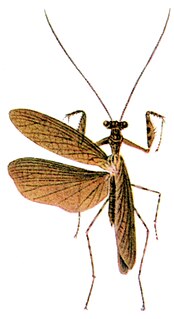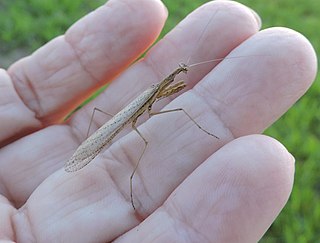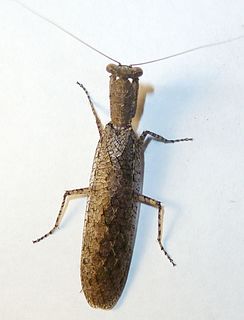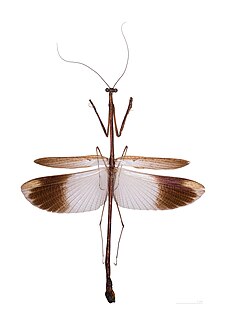
Hierodula is a genus of praying mantids in the tribe Hierodulini, found throughout Asia. Many species are referred to by the common name giant Asian mantis because of their large size compared to other mantids. Their large size and vibrant coloration make Hierodula mantids popular in the pet trade. Some widespread species include H. membranacea and H. patellifera; however this has been considered a 'catch all' genus and is currently subject to review. In 2020, three species were moved to a new genus, Titanodula.

Sphodromantis is a large genus of praying mantises concentrated in Africa, sometimes considered a synonym of the genus Hierodula: from the same tribe, Paramantini. Outside their range especially, many share the common name African Mantis.
Bantia is a genus of mantises in the family Thespidae.
Bolivaroscelis is a genus of praying mantis in the family Amorphoscelidae.
Hierodula werneri is a species of praying mantis in the family Mantidae.
Bantia chopardi is a species of praying mantis in the family Thespidae.
Bantia fusca is a species of praying mantis in the genus Bantia in the family Thespidae.
Bantia marmorata is a species of praying mantis in the family Thespidae.
Bantia metzi is a species of praying mantis in the family Thespidae.

Bantia michaelisi is a species of praying mantis in the family Thespidae.
Bantia nana is a species of praying mantis in the family Thespidae.
Bantia pygmaea is a species of praying mantis in the family Thespidae.
Bantia simoni is a species of praying mantis in the family Thespidae.
Bolivaroscelis werneri is a species of praying mantis in the family Amorphoscelidae.

Thespidae is a family of Neotropical insects in the order Mantodea. Following a major revision of this order in 2019, the old-world subfamilies Haaniinae and Hoplocoryphinae, previously placed here, have been upgraded to family level.

The bark mantises and ground mantises are praying mantids now placed in the family Eremiaphilidae that are native to the Afrotropics. They are generally light brown but more silvery on the wings. The wings are attractively reticulated, and the veins may be mottled dark and pale. The head is wider than the pronotum, which is rounded anteriorly, and doesn't overlap with the rear of the head. The pronotum is depressed, with its sides more or less parallel, and only a weak supra-coxal bulge is present. The anterior tibia are flattened and greatly expanded longitudinally, and the tibial claw does not fit into a pit between the 1st and 2nd external spines of the anterior femora, as in a few mantis groups.

Mantises are an order (Mantodea) of insects that contains over 2,400 species in about 460 genera in 33 families. The largest family is the Mantidae ("mantids"). Mantises are distributed worldwide in temperate and tropical habitats. They have triangular heads with bulging eyes supported on flexible necks. Their elongated bodies may or may not have wings, but all Mantodea have forelegs that are greatly enlarged and adapted for catching and gripping prey; their upright posture, while remaining stationary with forearms folded, has led to the common name praying mantis.
Metoxypilus werneri is a species of praying mantis found in New Guinea.

Angelidae is a family of mantises found in tropical Central and South Americas.







